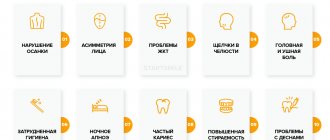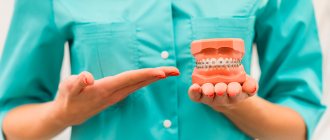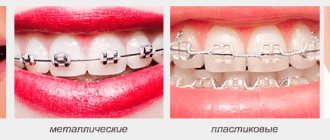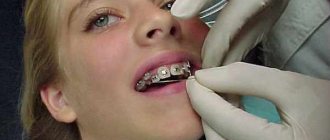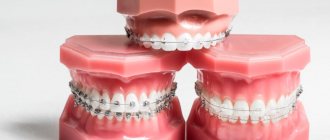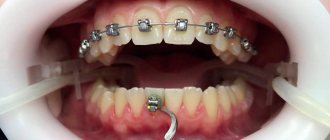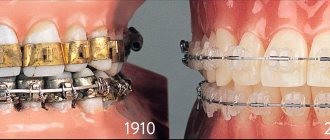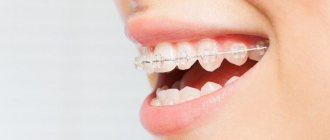The effectiveness of orthodontic correction of defects of the dental system directly depends on the age of the patient. It is considered optimal to carry out treatment in children at the stage of mixed and emerging permanent dentition. In this regard, correction of dentition defects is one of the most important areas of pediatric dentistry.
If the time for wearing plates is missed, braces can be used in children. For some reason, it is believed that this orthodontic structure cannot be used until adolescence. At the same time, it is in children that the bite problem can be solved most simply and quickly, without waiting for crooked teeth to become “overgrown” with complexes, a feeling of insecurity about one’s own attractiveness and problems in interpersonal communication.
The principle of operation of the braces system
Orthodontic construction, widely used to give teeth the correct position in the jaw, consists of a number of individual elements. First of all, these are clasps that are attached to the enamel surface. They are united into a single system by a force arc - a thick wire that creates the necessary pressure on the teeth.
Braces (clasps), individual elements with special grooves or clips for wires, are necessary to fix the structure on the teeth. Most often they are made of metal, but there may be other options. The clasps are held on the surface of the tooth using a special dental adhesive.
Dental wire is no different in appearance from ordinary metal wire and is gray in color. In expensive orthodontic systems, which are almost invisible on the teeth, white wire may be used. A feature of the arc is “shape memory”. Initially, it has a configuration that corresponds to an ideal bite. When the wire is deformed by the doctor during the installation of the system, it tends to return to its original position, pulls the clasps with it and thus helps correct the position of the teeth.
When is it necessary to bring a child to an orthodontist?
Let’s look at when a teenager needs braces:
- Large gaps between teeth (trema and diastema);
- Crowded teeth (severe lack of space);
- Untimely tooth loss;
- Various bite pathologies: distal, mesial, open, deep or crossbite.
Features of the children's braces system
Nowadays, orthodontic treatment can be performed on patients of all ages. Dentists actively encourage adults to correct their bite. At the same time, children and adolescents with crooked teeth, for whom the optimal period for correcting dentoalveolar anomalies has arrived, fade into the background. From 12 to 18 years of age, active formation of the jaws occurs, the tissues are flexible, and the teeth respond well to the pressure exerted on them. You can achieve the desired result with the least effort. However, for some reason many adults believe that “the child will outgrow it” and “the teeth will straighten out on their own.”
Up to 12 years of age, during the period of mixed dentition, orthodontic correction can also be carried out. However, the bracket system cannot be used for this purpose, since during this period the pressure of the structure is excessive. It is more advisable to use plates and other orthodontic devices that have a softer and more gentle effect on the dental system.
The age for starting orthodontic correction using a brace system at 12 years is indicated very arbitrarily. The development of children is uneven, so the orthodontist must take into account the individual characteristics of the young patient when determining the indications for starting treatment. The specialist’s decision is based on data from a dental examination and x-ray examination. In fact, the child undergoes the entire range of diagnostic tests that are necessary for an adult patient in the same situation. However, the objectives of the examination differ, just like the algorithms for determining indications and contraindications for treatment.
Children's braces, in addition to a special approach to installation, differ from adults in a shorter wearing period. However, the cost of orthodontic correction in children and adolescents may exceed that in adults.
At what age can you get braces?
Since a free consultation with an orthodontist is available to everyone, visiting a doctor with a child today is the same common practice as a dental examination of a schoolchild or teenager.
However, it is worth taking into account that during the first five years of a child’s life, an examination by an orthodontist is not recommended. An appointment with a specialist is justified if the child is already five years old and the parents are concerned about his bite for one reason or another.
During the appointment, the orthodontist will evaluate the correct development of the young patient’s jaw bones, the timeliness of the eruption of his permanent teeth and the nature of the bite problems, if any, and will also offer treatment options to the parents.
The “Full Order” clinic in St. Petersburg has qualified orthodontists who will gladly accept not only adult clients, but also children!
Types of children's braces
A fairly large number of modifications of brace systems have been developed and are used, which differ from each other in the location of the structure in the oral cavity and the material from which the clasps are made. Most types of systems can be successfully used in patients of all ages, starting from 12 years of age.
Ways to arrange the structure
Most often in the practice of an orthodontist, vestibular corrective structures are used. Vestibular clasps are attached to the outer surface of the dental crown. Such a device is much easier to install, adjust, and clean from plaque and food debris. Obvious shortcomings include the unaesthetic appearance of the system, which is visible when smiling and during a conversation.
Lingual braces, which are installed on the lingual surface of the teeth, are completely invisible to others and are just as effective as vestibular braces. However, they are made individually from gold and other expensive metals, which determines the high price of the structure. A system for one jaw can cost a patient 120 thousand rubles or more. The system also significantly reduces the oral cavity and limits the movement of the tongue, which affects diction.
For children and adolescents, the aesthetic side of the issue of orthodontic correction is very acute. Any comments or non-verbal signs of disapproval from peers regarding “braces on the teeth” may lead to refusal to continue treatment.
Classification by location: vestibular and lingual braces
Another important criterion when choosing a brace system for bite correction is the location of the locks. There are two types of systems, each of which is actively used in orthodontics:
- 1. Vestibular braces (standard, visible). Classic designs that are attached to the front surface of the teeth. These braces allow you to correct any type of malocclusion, regardless of severity and complexity. However, even the most aesthetic clasps made of ceramic or sapphire will still be noticeable on the teeth.
- 2. Lingual braces (they are also called “invisible braces”, or internal). They are installed on the inner surface of the dentition, so they are completely invisible. Minus - they have a number of restrictions for use. In particular, they are not suitable for defects that are too complex .
If you are thinking about which braces are best for a girl, a shy child or an adult, then lingual systems are best suited. However, the decision must be made together with the orthodontist.
Ligature and self-ligating systems
Ligatures are additional elements of the bracket system that hold the arch in the groove of the lock. At the initial stage of treatment, pieces of thin wire are used as ligatures. Then they are replaced with elastic bands. The main purpose of the ligatures is to ensure the movement of the clasps following the changing shape of the arch. The wire fixes the braces very tightly, which often leads to uneven load on the teeth. In this regard, aching pain may appear that an adult, let alone a child, can hardly endure. Rubber bands are stained with pigments from food and drinks, which requires their regular replacement.
In self-ligating systems, the clasps have a special clip that secures the arch. The connection using a clip is not as rigid as using a wire ligature. As the teeth shift, the clasps can move within a small range relative to the power arc, which allows the load on the dental system to be distributed more evenly.
It is impossible to say for sure which system is better. Each of them does an excellent job of eliminating dental defects. The duration of treatment does not depend on the type of structure used. The patient will have to visit the dentist to correct the system with approximately the same frequency. Ligature-free systems are made from a variety of materials, which allows you to “play” with shape and color. Ligature rubber bands can be of a variety of colors, which, if desired, allows you to turn an orthodontic structure into a stylish accessory.
Braces for a teenager: PROS and CONS?
Despite the fact that conscious parents are concerned about the health of their children, many of them often do not pay attention to minor deviations that become pronounced around the age of 12 years of a child’s life.
An incorrect bite is not just an “imperfect smile” that does not allow a child to openly express emotions and be self-confident. Along with the aesthetic side of the issue, malocclusions have an impact on overall health, since in the human body all processes are interconnected:
- Difficulty in proper hygiene and, as a result, caries and tooth decay;
- Uneven distribution of load on the jaws (teeth wear, bruxism, damage to the jaw muscles, clamps and headaches);
- Diction;
- Problems with breathing and ENT organs;
- Distorted face shape, facial expressions, wrinkles;
- Posture (improper position of the jaws and head, which causes the skeleton to suffer);
- Mental health (from childhood a person feels like a “blank spot”, which can affect his self-identification and socialization in society)
Moreover, the sooner concerned parents contact an orthodontist, the easier and faster the treatment will be.
Types of braces depending on material
Metal locks are the most reliable. They are small in size, securely attached to tooth enamel, and are the most durable of all. They are also the most affordable. Their widespread distribution is hindered by the unattractive appearance of the metal structure on the teeth. As a rule, in order to save money, metal braces are often used with ceramic and even sapphire ones, placing colorless elements on the front teeth, and reliable iron ones on large and small molars.
Metal locks are made of titanium, the power arc is made of an alloy of titanium and nickel. It is this combination that gives the product sufficient strength and the ability to withstand significant loads for a long time.
Ceramic braces come in many different shades. The color of the material can be matched to the natural color of the enamel, which will make the locks almost invisible. When producing braces, the greater fragility of dental ceramics compared to metal is taken into account, which is why ceramic clasps are larger than metal ones.
Sapphire braces are made from artificially grown gemstones. They are completely transparent and have a characteristic shine, reminiscent of the shine of jewelry. They are more durable than ceramic and do not change color under the influence of external factors. If you use a white rather than a gray archwire for sapphire clasps, the design becomes almost invisible in the mouth. The only drawback of the sapphire bracket system is its high cost, which significantly “bites” even if some of the clasps that are not visible during a conversation are replaced with metal ones.
Which braces are better?
The final decision about which braces are best for you or your child is always the result of an analysis of a set of factors and conditions. The choice depends on the condition of the tooth enamel, the degree of curvature of the teeth, the patient’s age, budget, and individual contraindications (for example, an allergy to metal).
What braces are best for adults?
Age is one of the key factors in selecting an effective treatment program. What braces are best for adults? As our experience shows, there can be several correct solutions:
- metal structures are optimal if the key condition is the cost of treatment;
- ceramics are optimal for business people who do not want to draw attention to a temporary structure; or allergy sufferers;
- People with high sensitivity of teeth, gums and mucous membranes should vote for an external self-ligating system - such braces are easier to tolerate in adulthood and give an excellent effect.
What braces are best for a teenager?
When choosing which braces are best for a teenager, you should rely on two non-financial factors: the age/character of the child and the degree of malocclusion. At an earlier age, classic metal braces are recommended for children. You can choose original ligatures for them - with a pattern, glowing in the dark, multi-colored. Young patients like this treatment format, plus the design of the onlays can be changed every 2-3 months.
When deciding which braces are best for a teenager, reviews from the attending physician about popular designs for a specific age category are indispensable. At an older age or for very shy children, ceramics are recommended. It is not visually striking, and, therefore, will not give rise to the development of complexes. The effect of treatment with ceramic structures on children’s/teenage teeth is excellent.
Invisible structures for a teenager are an ineffective solution, since his jaw is constantly changing and growing. Considering that such special structures are made strictly for specific jaw sizes, the child may simply outgrow them before the end of the therapy cycle.
Braces or aligners
Psychological preparation of the child
Not every parent can afford orthodontic treatment using sapphire or lingual braces. Yes, this is not always necessary. In addition to the fact that vestibular braces look unsightly, it is necessary to remember that the teeth hurt for the first time after installation, the structure is difficult to clean, and it is even difficult to eat with it. The right attitude helps a teenager cope with discomfort, find ways to turn design flaws into a reason for self-expression (choose colors and color combinations of ligatures, for example).
It is important to respect the child’s opinion and take into account his interests. You should not hush up possible problems associated with everyday wearing of the device, so that later the difficulties do not become an unpleasant surprise for the young patient and cause a decrease in motivation to continue treatment. Carrying out bite correction should be the decision of the child, and not the adults around him, since this is a complex and quite uncomfortable matter.
At the age of 12, not many children think about the need to correct their bite. It is necessary to develop in them an understanding of the importance of the beauty of a smile in interpersonal communication, an understanding of the relationship between the state of the oral cavity and the general state of human health. Well, the most important thing. Even before installing the system, it is necessary to take care of acquiring purely practical skills in caring for the structure. It will be much easier for a young patient to brush his teeth and braces with them if he has already formed the habit of using zuna floss, an irrigator, and mouth rinse.
Parents can teach their child by example by mastering the correct method of brushing teeth and using it regularly. All family members will benefit from this. Also, the time a child wears braces can be used to change the diet of all members. An orthodontic patient cannot eat solid food, so any chips and crackers are prohibited. Sticky and viscous products will take a long time to clean out from the spaces between the enamel and the arc. Changing the diet will allow you to avoid situations where the child feels deprived and switch to eating more healthy foods.
Braces care
In order to clean your teeth and structures from dirt every day, you will have to purchase several special devices at once:
- An orthodontic toothbrush, thanks to its special shape and softer bristles, cleans teeth more thoroughly without the risk of the clasps coming off;
- small brushes, the heads of which are placed between the arch and the surface of the teeth;
- dental floss;
- a special toothpaste and rinse that inhibits the growth of bacteria in the oral cavity after brushing;
- irrigator, a special device that allows you to clean plaque from places where a brush and brushes cannot reach.
The child should be prepared to spend much more time than usual on hygienic cleaning. Especially if before that he did not use a toothbrush every day. The braces system increases the likelihood of developing caries, so you will have to take extra care of your teeth throughout the entire treatment period.
Choosing a brace system for treatment – h4 braces
To correct a child’s bite, self-ligating H4 braces
- so-called HFO braces, which were installed on the upper and lower jaws. The h4 bracket system is today considered one of the most progressive systems for aligning and correcting bites.
This system is not fixed traditionally, but higher than usual
, that is, on the upper teeth it is as close as possible to the gum, so when talking they are simply not visible, this is an excellent solution for those who are worried about aesthetics.
Therefore, h4 braces are ideal for children
, allowing them not to be embarrassed about their smile. This is what h4 braces look like in the photo immediately after installation on the upper jaw teeth of our young patient:
You can immediately highlight the differences between this h4 braces system and other types of braces, which we talked about earlier. After fixing braces on both jaws, we began monitoring our young patient, periodically inviting her to appointments and making planned changes in the arch and adding special orthodontic techniques.
Cost of braces
When discussing the cost of orthodontic treatment, many parents focus only on the price of the braces system. This is one of the most significant expense items, but far from the only one. The average cost of a metal structure per jaw is about 60 thousand rubles. The sapphire system will cost twice as much. It is also necessary to take into account the cost of examination, sanitation of the oral cavity, periodic scheduled examinations to adjust the system, professional oral hygiene procedures once every 3 months. Do not forget about force majeure, when you will have to contact an orthodontist unscheduled. This is a broken arc, unsticking of a lock and other damage that must be removed in a timely manner.
How much do braces cost for a teenager's teeth?
Prices for braces for a teenager in Moscow can vary from 125 to 450 thousand rubles. For example, the fixed cost of aligners includes not only the system itself, but also the services of an orthodontist, whereas when installing braces, the total cost does not include tightening the arches and replacing system elements in the event of breakage or loss. Not only the choice of correction device influences, but also the manufacturer’s brand, duration of treatment and the overall clinical picture.
If you want to know how much braces cost for a teenager, you need to undergo an examination and consultation with a doctor to make the final calculation and make a decision.
